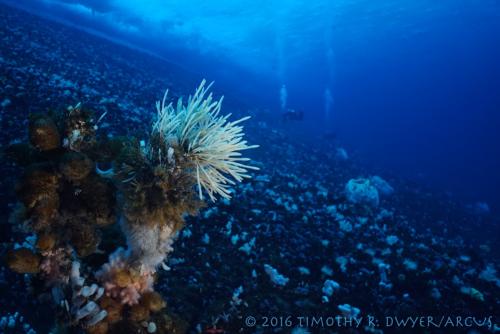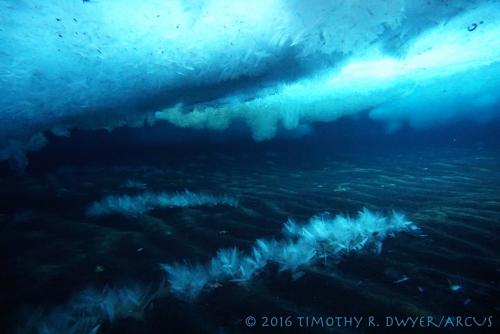
Having just clawed my way up the ladder into the dive hut after another otherworldly visit beneath the ice, diving supervisor Rob Robbins asks, "Hey Tim, does your face hurt?" "Actually, I can't really feel it right now," I tell him. "Really?" Rob says, "Because it's killing me!" I take off my weights and mask, and drip dry all over the floor, thinking, "Nice one, Rob." "Seriously though," Rob confides, "This is my favorite dive site. Anywhere." Coming from a guy with thousands of dives in Antarctica and thousands more the world over, that's saying a lot. "How'd you find the site?" I ask. And so begins a conversation about site selection for Antarctic diving.

Even though the expanse of sea ice seems endless, there are relatively few locations that meet a strict set of criteria which Rob applies when finding places for researchers to dive. The Ross Sea and McMurdo Sound get very deep - well below our permitted diving depth of 130ft/40m - so dive sites need to be located close to shore. However, sea ice has a tendency to pile up and crack where it interfaces with the land, making hole-drilling difficult and dive hut-placing a dicey proposition. Rob looks for locations that can be accessed from above with a gentle enough landward slope that divers don't have to swim to their depth limit when finding the bottom at the beginning of the dive. It's also helpful to have a reachable working depth beneath the hole should equipment get dropped and need to be recovered, (which does happen).

During the course of our conversation, Rob explains that he's also looking for habitat variety when choosing sites. For example, the day's dive at Cape Evans Wall found us swimming above the steep, broken, boulder strewn bottom of a rock wall split by millenia of freezing and thawing in the elements above. The Arrival Heights dive site is a sloping, soft sediment environment typified by colossal barrel sponges dotting a carpet of anemones, tunicates, soft corals, and smaller sponges. At Turtle Rock, the ice-cave-like sandy shallows give way to granular volcanic rock sloping gently into the blue and covered by a forest of tiny white anemones. For our sea spider collection purposes, each of these sites may offer conditions that favor one size range or species group over another. We will systematically check eight or nine different sites and return to the ones that offer the most efficient opportunities for spider collection and in situ experiments. It's a lot of effort but the variety of marine habitats I'm able to explore will have me telling stories for years to come.



Comments